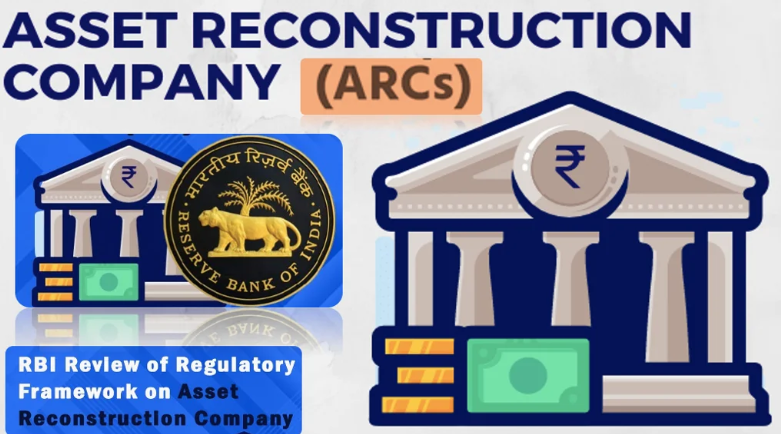Concerns and Challenges Facing Asset Reconstruction Companies (ARCs) (GS Paper 3, Economy)

Introduction
- Asset Reconstruction Companies (ARCs) play a crucial role in the financial sector by managing and recovering non-performing assets (NPAs) from banks and financial institutions.
- However, recent developments have posed significant challenges to their growth and effectiveness.
- Notably, the decline in NPAs and regulatory changes have impacted ARCs' operations.
- This article delves into the concerns surrounding ARCs and suggests potential measures to address these challenges.
Current Concerns for ARCs
Diminished Business Prospects
- Decrease in NPAs: The level of NPAs in the banking sector has hit a 12-year low, reducing the pool of distressed assets available for ARCs to acquire. This has shifted ARCs' focus towards smaller, less profitable retail loans, which have not seen a significant increase in NPAs.
- Limited Opportunities: The reduced volume of new non-performing assets has restricted ARCs' business potential, hampering their ability to expand and diversify.
Increased Investment Mandates
- Regulatory Requirements: In October 2022, the Reserve Bank of India (RBI) mandated that ARCs must invest a minimum of 15% of bank investments in security receipts or 2.5% of the total security receipts issued, whichever is higher. This increased capital requirement places an additional burden on ARCs and affects their operational flexibility.
Higher Net Owned Funds Requirements
- Capital Constraints: The RBI raised the minimum net owned funds requirement for ARCs from ₹100 crore to ₹300 crore. This decision aims to ensure that ARCs maintain robust balance sheets, but it has imposed significant constraints on their capital usage, leading to financial strain and potential consolidations or exits.
Competition from National Asset Reconstruction Company Ltd (NARCL)
- Government-Backed Rival: The establishment of NARCL, a state-owned entity, has intensified competition. NARCL's security receipts are government-backed, making them more attractive to financial institutions compared to those offered by private ARCs.
Regulatory and Compliance Challenges
- Approval Delays: ARCs are now required to obtain approval from independent advisory committees for all settlement proposals. This has led to delays, particularly for retail loans, as committees are cautious to avoid future scrutiny.
- Increased Scrutiny: The RBI has heightened its scrutiny of ARCs, with actions such as banning Edelweiss ARC from new loans for regulatory violations impacting the sector's stability.
Trust Deficit
- Regulatory Concerns: There is a growing trust deficit between ARCs and the RBI. The regulator has raised concerns about some transactions potentially helping defaulting promoters regain control of their assets, circumventing provisions of the Insolvency and Bankruptcy Code (IBC), specifically Section 29A, which prohibits defaulting promoters from bidding for their insolvent firms.
Overview of ARCs
Definition and Function
- Role: ARCs are financial institutions that purchase distressed assets from banks and attempt to recover these debts or associated securities. They are primarily guided by the Securitisation and Reconstruction of Financial Assets and Enforcement of Security Interest Act, 2002 (SARFAESI Act, 2002).
Regulatory Framework
- Registration: ARCs must be registered under the Companies Act, 2013 and with the RBI under SARFAESI Act. They raise funds from Qualified Buyers (QBs) to acquire and manage distressed assets.
Recent Regulatory Changes
Governance Enhancements
- Board Composition: The RBI now mandates that ARCs must have independent directors in key board positions to strengthen corporate governance.
Transparency Improvements
- Disclosure Requirements: ARCs are required to disclose their performance track records and collaborate with rating agencies to enhance transparency.
Revised Investment Mandates
- Investment Requirements: ARCs must invest at least 15% of the transferors' investment or 2.5% of the total security receipts issued, whichever is higher.
Proposed Measures to Address ARCs' Challenges
Diversification of Asset Portfolios
- Expand Horizons: ARCs should diversify their portfolios beyond traditional corporate and retail loans to include sectors like infrastructure, MSMEs, and other stressed sectors with recovery potential.
Improving Regulatory Transparency and Collaboration
- Enhanced Cooperation: ARCs should engage proactively with the RBI and other regulatory bodies to ensure compliance and improve transparency. Establishing a standard code of conduct could help in building trust and accountability.
Enhancing Efficiency in Settlements
- Technology Integration: Adopting technology, such as AI-driven analytics, can streamline settlement processes and reduce delays while maintaining regulatory compliance.
Strategic Competition with NARCL
- Specialized Services: Private ARCs should differentiate their offerings by developing specialized solutions or focusing on innovative recovery mechanisms to stay competitive against NARCL.
Conclusion
- The asset reconstruction sector faces significant challenges including reduced NPAs, increased regulatory demands, and heightened competition.
- By diversifying asset portfolios, improving transparency, and leveraging technology, ARCs can better navigate these challenges and enhance their role in managing distressed assets.


